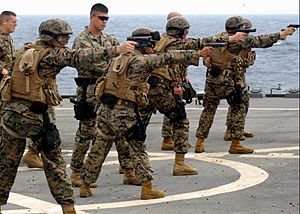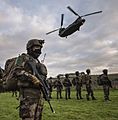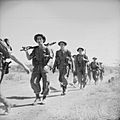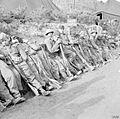Battledress facts for kids
Battledress is a special type of military uniform that soldiers wear when they are going into combat or training for it. It's different from the dress uniforms worn for parades or formal events. Battledress is made to be practical and help soldiers do their jobs safely. It can be a single color, like green or brown, or it can have military camouflage patterns. These patterns help soldiers blend in with their surroundings, making it harder for enemies to see them.
Contents
Why Soldiers Wear Battledress
Soldiers wear battledress for several important reasons. The main goal is to keep them safe and help them perform well in tough situations.
Protection and Safety
Battledress is often made from strong, durable fabrics. These materials can protect soldiers from scratches, scrapes, and harsh weather. Modern battledress might also include special features. These can be things like flame-resistant materials or places to attach body armor. This armor helps protect against bullets or shrapnel.
Blending In with Camouflage
One of the most important features of battledress is military camouflage. Camouflage patterns are designed to break up a soldier's outline. This makes them harder to spot against different backgrounds. For example, a uniform with green and brown patterns works well in forests. A uniform with sandy colors is better for deserts. This blending in is super important for staying hidden from enemies.
Carrying Gear
Battledress uniforms are also designed to be practical for carrying equipment. They often have many pockets for things like maps, first-aid kits, or extra ammunition. Soldiers might also wear special vests or belts over their battledress. These allow them to carry even more essential gear.
The History of Battledress
Military uniforms have changed a lot over hundreds of years. Early soldiers often wore bright, colorful uniforms. These were meant to look impressive and show off their army. However, these bright colors made them easy targets in battle.
From Bright Colors to Khaki
During the 19th century, armies started to realize that bright uniforms were not practical for combat. They began to switch to more dull colors. The British Army was one of the first to widely adopt "khaki" uniforms. Khaki is a dull yellowish-brown color. This change happened during conflicts like the Second Boer War. Soldiers found that khaki helped them blend into the dusty landscapes.
The Rise of Camouflage Patterns
The idea of using patterns to hide became popular in the 20th century. During the First World War, armies started experimenting with camouflage. They painted vehicles and equipment to blend in. By the Second World War, many armies began using patterned battledress. These early patterns were simple, but they were a big step forward.
Modern Battledress
Today's battledress is very advanced. It uses high-tech fabrics and complex camouflage patterns. Some uniforms can even help regulate a soldier's body temperature. Others are designed to be lightweight and breathable. Different countries and even different branches of the military have their own unique battledress designs. These designs are constantly updated to meet new challenges.
Images for kids
-
Troops from the Uzbek Ground Forces dressed in combat uniform during a military parade in Moscow.
-
Canadian soldiers in service dress during the First World War
-
A Canadian contingent in Hong Kong wearing Khaki Drill uniform
-
French soldiers during the Battle of the Somme, 1916
-
M36 uniform worn by enlisted Wehrmacht infantry
-
Imperial Russian Army soldiers inspect an auto wreckage, 1915
-
Historical reenactors depicting the New Model Army during the Battle of Naseby. Most British soldiers fought in red-coloured coats/tunics from the 17th to 19th century.
-
Members of the Black Watch in combat uniforms relaxing during the Korean War





























